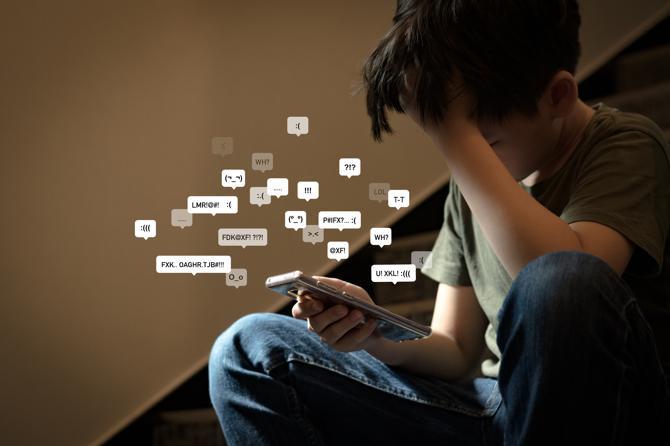Cyberbullying: What is it?

In recent decades, bullying (as many parents have known it) has drastically evolved and is no longer limited to after-school scraps or hurtful comments during recess. In keeping pace with today’s technology, the practice of bullying has firmly integrated itself into cyberspace. Known legally as “cyberbullying”, the shift to the internet has amplified the devastating impacts that bullying can have on a person’s well-being and health. This is largely due to digital communication mediums being able to facilitate a rapid distribution and variety of hateful content.
Today, what may start as a petty playground fight can quickly escalate to hundreds of abusive messages in a short amount of time. Sometimes, instances of cyberbullying can even end in tragedy. As it stands, the best way to stop cyberbullying (as a parent or child) is to understand as much as possible about it, which is why we’ve created this guide. Help bring an end to cyberbullying today.
Examples of Cyberbullying
Cyberbullying (sometimes referred to as online bullying), by definition, is the practice of using digital technology, such as a phone, tablet, gaming console, or computer, to bully another person (or people) via email, direct messaging platforms, social media, audio and video platforms, or text messaging. This includes the sharing or posting of content aimed at causing the embarrassment or humiliation of another person. According to the National Center for Education Statistics and Bureau of Justice, 16 percent of students in the US, from grades 9–12, have personally experienced cyberbullying in some form (that’s approximately 1 in 6 children).
With its link to social media and the internet at large, it can sometimes be difficult to spot an example of cyberbullying. Even more worryingly, some cases of cyberbullying can turn into larger criminal acts very quickly. As a result, we’ve listed some of the most prominent examples of online bullying, so you can be prepared moving forward.
Direct Harassment: This includes hateful, insulting, or rude text messages, emails, or comments (in a forum or via social media); the use of chat groups as a way of ganging up on someone digitally; posting offensive, racist, or insulting content on the public spaces of the victim’s social media profiles that directly attacks them or their digital image.
Forgery and Impersonation: Cloning or making duplicate accounts (including email, phone numbers, Facebook, Twitter, Instagram, etc.) of the victim’s own account and posting offensive or unwanted content online with the fake accounts; hacking into someone’s online profile and changing their personal information without their permission; “Catfishing”, the term used to describe tricking a victim into a relationship with a fake online account.
Information Theft and Unlawful Sharing: Posting publicly (on social media) or sharing between other people, without consent, explicit or sexual images or videos of a person; taking nude, explicit, or degrading photos of a person without their informed consent; the recording or sharing of videos, or images that depict the physical bullying of the victim; spreading rumors or information designed to denigrate someone; sharing personal information or explicit images/videos of someone on another website online.
Many of the examples above are considered in many states now to be illegal and should be treated as a police matter. If you’re not sure, you should always contact your local law enforcement agency to confirm.
Effects of Cyberbullying
As a form of bullying, the effects of cyberbullying are often shocking, sometimes tragic, and can last well into adulthood. Children who are the victims of bullying can develop a range of different mental health problems, including depression and various anxiety disorders. They are also likely to have fewer friendships, find it difficult to adjust to schooling, and be more suspicious of other people around them.

How to Prevent and Stop Cyberbullying?
Like physical bullying, there are a number of measures that you can take (as an adult or a minor) to prevent cyberbullying from continuing.
Tell Someone
According to a study on the long-term effects of bullying the vast majority of teenagers, up to 90% by some estimates, agree that cyberbullying is a problem, with other estimates citing around 63% of teenagers believing it to be a “serious” problem. Unfortunately, many young people also believe that schools, the government, and social media companies are failing to address the problem, leaving many of them feeling disenfranchised and isolated. In stark contrast, many teenagers see their parents as effective allies in the fight against cyberbullying. This leaves a large responsibility in the hands of the parents to remain vigilant and reach out to their children if they think there could be a possible incident of cyberbullying.
In many cases, teenagers will hesitate to tell their parents or other adults if they are the victims of cyberbullying. Similar to other forms of bullying, this lack of communication tends to stem from embarrassment or fear. Victims often worry that teachers and parents won’t be able to stop the abuse and that the harassment will only worsen once the bully finds out that they’ve told an adult. If you believe that your child is being cyberbullied (or is a cyberbully), it’s critical for you to reach out as soon as possible. Look for practical ways to address the issue, such as involving school administrators and/or a therapist. If you think that you are the victim of cyberbullying, tell a teacher, parent, or appropriate adult immediately.
Keep Everything
Once you’ve reached out to your child, save all posts, digital messages, and communications from the cyberbully by taking screenshots, or photos on your smartphone. In addition, make sure to record the time and date, and any other relevant information that could be used in a court of law. Bring everything to the school administration and consider involving the police if you feel that things are severe enough. In many cases, cyberbullying crosses the line from aggravation to criminal harassment.
Don’t Engage
With increases of up to 70% in the amount of bullying/hate speech among teens and children since the Covid lockdown, researchers have found non-engagement to be one of the main ways to combat certain kinds of cyberbullying attacks. Victims of cyberbullying are often better off ignoring or avoiding an attack and immediately reporting the situation to an appropriate adult. The goal of any bully is to goad his or her victim into anger and acknowledgment of ridiculous claims or malicious statements. Ignoring a cyberbully’s attempts minimizes their power in the digital setting. Equally, those observing the attacks must be willing to report problems to friends, family members, or teachers.
The best option for victims is to block the bully from social media and email accounts altogether. For many social media apps, such as Facebook or Instagram, blocking not only removes the bully from the victim’s view but also means that the bully can no longer directly link to the victim’s profile or even see posts by mutual contacts that tag the victim.
Learn More
According to enough.org, as of December 2022, nearly half (46%) of all young people (aged between 13 and 17) had been the victims of cyberbullying, with online surveys reporting that teachers consider cyberbullying to be one of the main classroom safety problems they face today. As parents, it’s crucial to learn all you can about what your children are doing on the internet and with their smartphones. Consider cybersecurity options dedicated to keeping kids safe online and taking more stringent measures to safeguard your children online.
One common misconception is that boys are always the aggressors and that girls are more likely to be the victims. In fact, studies suggest that girls are just as likely as boys to be both victims and bullies, with boys being more likely to be cyberbullied whilst using a gaming console and girls being more likely to be cyberbullied via social media.
Understand the Scope
Many adults believe social media sites are the most likely stages for cyberbullying behaviors, which in many cases is true. However, with around 95% of American teenagers having access to a smartphone (and 45% of teenagers reporting near-constant online activity), many adults and parents alike may be unaware of the potential scope for cyberbullying amongst adolescents. Whilst cyberbullying can occur via Facebook, Twitter, Instagram, TikTok, or Snapchat, emails, text messages, and direct messaging applications are equally ideal vectors for cyberbullying. With almost ubiquitous smartphone access and rapid changes in technology, it’s imperative to continuously monitor your children’s digital/internet-connected devices to stay ahead of any potential threats.
Recognize the Signs
Sometimes, a cyberbullied child looks the same as any adolescent— slightly closed off, often unwilling to talk about his or her day or disclose personal information. However, there are other, more subtle signs, that you should be on the lookout for, including a loss of interest in their favorite activities, an unexplained decline in grades, skipped classes, symptoms of depression, and changes in sleeping or eating habits. As these changes may also be indicative of other types of problems, be especially alert if you also notice a sudden lack of interest in using the computer or a tendency to become upset after being online or using their smartphone for a long period of time. In the case of a child who is an aggressor, watch out for extreme anger, if you take his or her phone or computer privileges away.
Keep Data Secure
In the cases of some of the most tragic cyberbullying incidents, the cyberbullies were able to set up fake Facebook profiles of the victims and deliver abuse through impersonation. As a result, it’s important for you and your teenager to be diligent when it comes to your online posting behavior. It’s also a good idea to limit the number of personal photos and information that you or your child posts online. Make sure they understand how to create secure passwords and know that they must be changed regularly.
As cyberbullies have also been known to hack or “hijack” their victims’ profiles to post rude and offensive comments, teenagers should always set their social media profiles to “private” and ignore messages from people they don’t know. Today’s comprehensive internet security solutions include password management tools and other cybersecurity features that can help keep your children’s accounts and online identities secure.
Don’t Get Turned Around
As noted by dosomething.org, some victims do fight back against their bullies, and then end up becoming bullies themselves. In an effort to defend themselves, the victim and aggressor become engaged in a “sort of back-and-forth”, which tends to escalate the bullying behavior (for both parties involved). Make sure to educate your child about being respectful of other people’s feelings and privacy online. Make clear that you understand the impulse to retaliate, but that in the long term, it’s best not to get involved.
Stand Together
It’s important to stand together and look for long-lasting solutions to cyberbullying. In 2015, Canada passed a bill into law that made it illegal to distribute images of a person without their consent and allows police to obtain a warrant for information about internet users based on “reasonable grounds to suspect” an offense has been perpetrated. The bill has since become a road map for future legislation to keep kids safe on the internet. Today cyberbullying carries a number of different legal implications under Canada’s Criminal Code, including criminal harassment, intimidation, extortion, identity theft, incitement of hatred, and defamatory libel.
In the US, cyberbullying can equate to many of the same charges (depending on the circumstances), but the laws vary by state. As a result, it’s important to understand your rights and escalate things to the proper authorities if they get out of hand or you feel in danger from cyberbullying.
Hold Bullies Accountable
Bark, the machine learning-based app, created “in collaboration with child psychologists, youth advisors, digital media experts, and law enforcement professionals”, offers monitoring and protection from both direct cyberbullying and the signs of being a victim of cyberbullying. In the first half of 2020 alone, it detected more than 165,000 instances of severe bullying.
The above statistics make it clear: cyberbullying is a persistent and serious problem. However, armed with data, what signs to look out for, and some actionable solutions, parents and teenagers can help turn the tide against cyberbullying.
Related articles:
- What are Password Managers and are they Safe?
- What is Cybersecurity?
- Internet Safety for Kids: Top 7 Internet Threats
- Internet Safety for Kids: Tips for Parents of Twitter Teenagers
- Internet Safety for Kids: 5 Quick Tips for Snapchat Security
- Internet Safety For Kids: How to Protect Your Child from the Top 7 Dangers of Online Gaming
- What is social engineering?
Recommended products:
Cyberbullying: What is it?
Kaspersky
We use cookies to make your experience of our websites better. By using and further navigating this website you accept this. Detailed information about the use of cookies on this website is available by clicking on more information.






